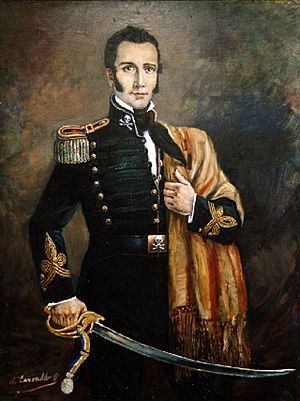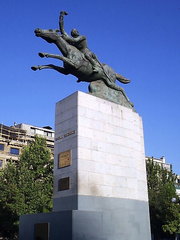Manuel Rodríguez Erdoíza facts for kids
Quick facts for kids
Manuel Rodríguez
|
|
|---|---|

Wearing his Húsares de la Muerte uniform
|
|
| Personal details | |
| Born | February 27, 1785 Santiago, Chile |
| Died | May 26, 1818 (aged 33) Tiltil, Chile |
| Signature | |
| Military service | |
| Battles/wars | |
Manuel Xavier Rodríguez Erdoíza (born February 27, 1785 – died May 26, 1818) was a brave Chilean lawyer and a clever guerrilla leader. Many people see him as one of the most important people who helped Chile become an independent country. He came from a family with Basque roots.
Contents
Early Life of Manuel Rodríguez
Manuel Rodríguez was born on February 27, 1785. His father, Carlos Rodríguez de Herrera y Zeballos, was a customs officer from Spain. His mother, María Loreto de Erdoiza y Aguirre, was a young lady from Peru.
Manuel went to a famous school called Carolino College. There, he was classmates with José Miguel Carrera, who would also become a key figure in Chile's independence. After college, Manuel studied law at the Royal University of San Felipe. He became a lawyer in 1807.
The "Patria Vieja" (Old Fatherland) (1810–1814)
On September 18, 1810, a special government group was formed in Chile. This group, called the Primera Junta Nacional de Gobierno, started the fight for Chile's independence from Spain.
In May 1811, Manuel Rodríguez became a lawyer for the city of Santiago de Chile. At first, he was not very extreme about independence. But then, his old friend José Miguel Carrera came back from Spain. Carrera was a strong supporter of revolution, and he inspired Manuel.
Later in 1811, Manuel was chosen to represent Talca in the government. He became the Secretary of War in November and joined the army as a captain in December.
By 1813, the friendship between Manuel Rodríguez and José Miguel Carrera had some problems. Carrera was now in charge of the Chilean government. Manuel and his brothers were accused of plotting against Carrera. They were sentenced to be sent away to Juan Fernández Islands for a year. However, Manuel found a way to stop this punishment.
Manuel and Carrera became friends again in 1814. The government group led by Carrera was replaced by a new one. Manuel Rodríguez often criticized this new government in a newspaper. When the Carrera brothers lost their power, Manuel helped José Miguel hide. Later, Carrera took control of the government again. He formed a new group and made Manuel its Secretary.
However, Spanish forces, led by General Mariano Osorio, were moving towards Santiago from the south. After a big defeat for the Chilean patriots at the Disaster of Rancagua, Spain took control of Chile again. Manuel Rodríguez, along with many other patriots, had to escape to Mendoza, in Argentina.
The Reconquest (1814–1817)
José de San Martín, who was the Governor of Cuyo in Argentina, welcomed the Chilean people who had fled. He started to create a "Liberation Army" with both Chileans and Argentinians.
San Martín saw Manuel Rodríguez as a perfect spy. Manuel was very smart and good at this job. Also, because he came from a humble background, he could easily pretend to be a common person. He started creating different disguises and ways to send secret messages. He often worked as a spy dressed as a monk, a farmer, a street merchant, a house helper, or even as a woman.
Manuel Rodríguez became the most wanted man during the time the Spanish Governor, Casimiro Marcó del Pont, ruled Chile. Manuel's surprise attacks on towns like Melipilla and San Fernando were very important. They helped San Martín's plan by making the Spanish army look in the wrong direction. This allowed the "Liberating Army" to enter Chile and win a big victory at the Battle of Chacabuco.
The "Patria Nueva" (New Fatherland) (1817–1818)
After the important victory at Chacabuco, the Chilean commander Bernardo O'Higgins ordered Manuel Rodríguez to be arrested. But Manuel managed to escape. He stayed hidden until San Martín stepped in to help him. San Martín then gave Manuel the rank of lieutenant colonel.
Later, the Spanish forces made a surprise attack at the Second Battle of Cancha Rayada. During this time, there were false rumors that O'Higgins had died. Manuel Rodríguez was very important in keeping Santiago calm and preventing panic. It was during this event that he said his most famous words: Aún tenemos patria, ciudadanos (We still have a fatherland, citizens).
After the events at Cancha Rayada, Manuel Rodríguez and other people who supported the Carrera brothers formed a special group of soldiers. They called themselves the Hussars of Death (Húsares de la Muerte). Their symbol was a white skull on a black flag. This showed that they were ready to die in battle rather than let the enemy win. However, this group was not chosen to fight in the important battle of Maipú. Later, Bernardo O'Higgins dissolved the group because he and San Martín did not agree with the Carrera brothers.
Assassination of Manuel Rodríguez
Manuel Rodríguez was killed on May 26, 1818, in Til-Til. He had been put in prison by order of O'Higgins. Soldiers from the "Cazadores de los Andes" battalion, led by Antonio Navarro, killed him without a proper trial. Many people believe that the head of the government was responsible for his death.
This event showed how much the people loved Manuel Rodríguez. It also showed their fear and dislike for O'Higgins' government.
Towards the end of the 1900s, Manuel Rodríguez's body was moved to the General Cemetery of Santiago. However, some recent research suggests that the body moved might not have been his. It might have been an older unknown soldier wearing the Husares de la Muerte uniform. Manuel Rodríguez was not wearing his famous uniform when he was killed. It is now thought that Manuel Rodríguez's body might still be buried in Til-Til's La Merced Chapel.
See also
 In Spanish: Manuel Rodríguez Erdoíza para niños
In Spanish: Manuel Rodríguez Erdoíza para niños


